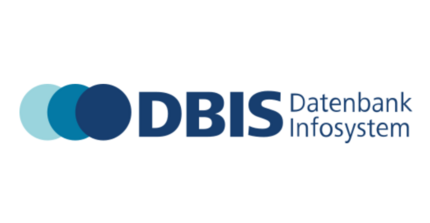Please close your eyes for a moment and imagine the library crammed full of paper. No, not just in the form of well-organised rows of books, but endless piles of paper spread out in the aisles and on the windowsills. Tables and chairs are no longer discernible. No way through, no light and certainly no orientation. Just a mass of paper with nowhere to go. This is roughly what the library would look like if we piled up everything we could offer you in printed form. Why does the library still look so tidy? Because we have been licensing databases and journal archives for years, which are just a few clicks away for you. So open your eyes again, because you'll need them for our short tour through the infinite expanses of DBIS, the database information system.
1. Daily newspapers
Eight daily newspapers can be read fresh from the press every day in our library. For reconstructing contemporary historical events newspaper archives are particularly suitable. The Neues Deutschland has been digitised with academic support from the ZZF and can be viewed and searched in facsimile on the Stabi homepage. The issues of the FAZ from 1949 onwards can be viewed in a similar way, but only on the premises of the ZZF. But that's not all: the archive of Izvestija , the most widely circulated Soviet daily newspaper, can also be browsed at the ZZF for the period from 1917 to 2001, and the archive of the Russian-language Pravda, the organ of the Communist Party, for the years 1912 to 2009 is also available via a national licence.
2. Newspaper reports
Before events can be commented on in newspapers, they must first be reported. Even before the dpa, the Austria Press Agency was founded in 1946 as a co-operative of Austrian newspapers. The founding statutes state that it was to provide an "independent news service for Austrian newspapers, regardless of their political or ideological leanings". The database summarises around three million reports from the years 1955 to 1985, which are so interesting from a historical perspective. Each APA report consists of the full text and a facsimile of the original report as a PDF file. As an additional service, dossiers on 52 topics can be called up.
3. Journals
As described above, libraries generally suffer from having far too little space. The requirement to keep as many academic journals available as possible regularly collides with the number of shelf metres. Libraries also want to be so much more than warehouses for paper. A start has been made at Harvard University with the Periodicals Index Online. This historical periodical index enables bibliographic searches in around 4,800 journals from the humanities and social sciences for the period from 1739 to 2000. This has resulted in the Periodicals Archive Online, which offers the full text of around 500 electronic journals with around 2 million articles from the years 1802 to 2000 in the fields of culture, humanities and social sciences. At the University of Michigan, the long-term archiving project JSTOR was created, which today represents one of the largest and most effective digital offerings for science. It offers access to primarily Anglo-American electronic journals in full text from their first volume up to a so-called "moving wall" (2-5 years before the current volume, depending on the title). The ZZF licence includes access to the full texts of the Arts and Sciences I – VII Collection (over 900 titles in total) and the Public Health Report. The DigiZeitschriften project has adopted this innovative concept for German-speaking countries and the online portal Persée for French-speaking countries.
4. Doctoral theses
Increasingly, doctoral theses in Germany are no longer being published by publishing houses but on the publication servers of the universities where they were written. On the one hand, this makes them readable without barriers, but on the other hand it also means that they are lost in the infinite vastness of the Internet. DART-Europe offers interdisciplinary worldwide access to European dissertations and is therefore not only suitable as a reference work, but also as a (digital) library. In the English-speaking world, it is rather unusual for dissertations to be published. However, if you would like to find out what doctoral theses have been published, the Dissertation Express database is a good place to start. It lists US dissertations since 1861 as well as Canadian dissertations. Additionally, British dissertations from January 1988 onwards are documented. The Bibliography of Doctoral Dissertations Accepted by American Universities published by the Association of Research Libraries, which lists around 1 million US dissertations from 1933 to 1955, has also been digitised and is therefore freely accessible.
5. Photo archives
The importance of photo archives for contemporary history should be generally recognised by now, not least thanks to the academic work of the ZZF. In addition to commercial agencies, such as the picture archive of the Ullstein publishing house, several large libraries manage impressive picture archives. The Bavarian State Library, for example, preserves a collection of portraits and prospects, the Heinrich Hoffmann, Gerhard E. Habermann, Bernhard Johannes and Felicitas Timpe photo archives as well as smaller, self-contained collections. The Heinrich Hoffmann and Bernhard Johannes photo archives have already been fully catalogued and digitised. The other sub-collections will follow. The Deutsche Fotothek in turn is administered by the Saxon State and University Library Dresden (SLUB). Of the more than 3.6 million archived image documents, around 1.5 million images can be researched online and are freely accessible. Among the photographers archived there are Roger Melis and Christian Borchert, who is currently exhibiting at our neighbours in Einstein Forum.
6. The National Security Archive of the USA
"Even the BND doesn't know what NSA selectors are looking for", was the recent headline in Die Zeit. The Digital National Security Archive, which is the most comprehensive collection of essential primary documents on US foreign and military policy since 1945, offers a rough historical overview, albeit hardly a complete one. The database contains over 50,000 documents, including presidential directives, memos, diplomatic dispatches, meeting notes, independent reports, briefings, communications from the White House, emails, confidential letters and more. An explanatory reference section with introduction, chronology, glossary and bibliography is included for each sub-collection, helping to put the material into context.
So, do you feel like browsing through the mountains of databases? Then take a look around DBIS yourself. This database information system contains well over 10,000 entries. Almost half of them are freely available on the internet. If you get lost or miss your bearings, we will be happy to help! Your library team.
(27.05.2015)

